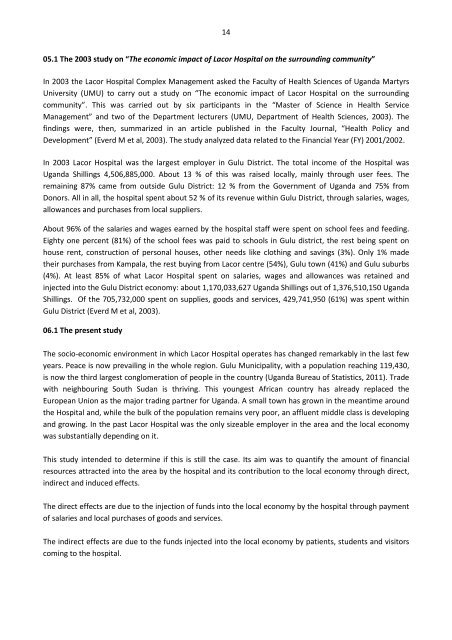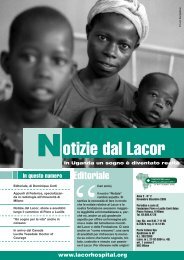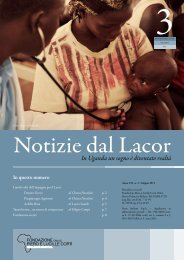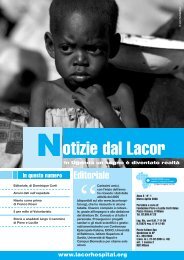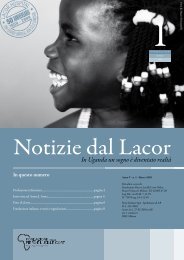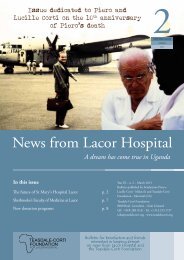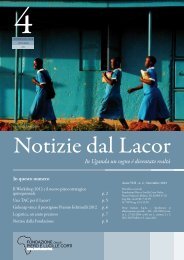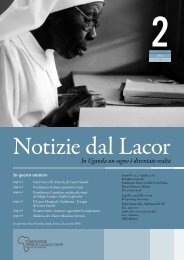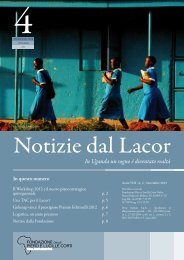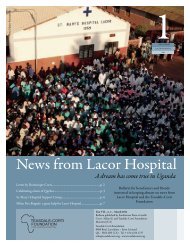Importance of LH on the local economy - Lacor Hospital > Home
Importance of LH on the local economy - Lacor Hospital > Home
Importance of LH on the local economy - Lacor Hospital > Home
Create successful ePaper yourself
Turn your PDF publications into a flip-book with our unique Google optimized e-Paper software.
1405.1 The 2003 study <strong>on</strong> “The ec<strong>on</strong>omic impact <str<strong>on</strong>g>of</str<strong>on</strong>g> <strong>Lacor</strong> <strong>Hospital</strong> <strong>on</strong> <strong>the</strong> surrounding community”In 2003 <strong>the</strong> <strong>Lacor</strong> <strong>Hospital</strong> Complex Management asked <strong>the</strong> Faculty <str<strong>on</strong>g>of</str<strong>on</strong>g> Health Sciences <str<strong>on</strong>g>of</str<strong>on</strong>g> Uganda MartyrsUniversity (UMU) to carry out a study <strong>on</strong> “The ec<strong>on</strong>omic impact <str<strong>on</strong>g>of</str<strong>on</strong>g> <strong>Lacor</strong> <strong>Hospital</strong> <strong>on</strong> <strong>the</strong> surroundingcommunity”. This was carried out by six participants in <strong>the</strong> “Master <str<strong>on</strong>g>of</str<strong>on</strong>g> Science in Health ServiceManagement” and two <str<strong>on</strong>g>of</str<strong>on</strong>g> <strong>the</strong> Department lecturers (UMU, Department <str<strong>on</strong>g>of</str<strong>on</strong>g> Health Sciences, 2003). Thefindings were, <strong>the</strong>n, summarized in an article published in <strong>the</strong> Faculty Journal, “Health Policy andDevelopment” (Everd M et al, 2003). The study analyzed data related to <strong>the</strong> Financial Year (FY) 2001/2002.In 2003 <strong>Lacor</strong> <strong>Hospital</strong> was <strong>the</strong> largest employer in Gulu District. The total income <str<strong>on</strong>g>of</str<strong>on</strong>g> <strong>the</strong> <strong>Hospital</strong> wasUganda Shillings 4,506,885,000. About 13 % <str<strong>on</strong>g>of</str<strong>on</strong>g> this was raised <strong>local</strong>ly, mainly through user fees. Theremaining 87% came from outside Gulu District: 12 % from <strong>the</strong> Government <str<strong>on</strong>g>of</str<strong>on</strong>g> Uganda and 75% fromD<strong>on</strong>ors. All in all, <strong>the</strong> hospital spent about 52 % <str<strong>on</strong>g>of</str<strong>on</strong>g> its revenue within Gulu District, through salaries, wages,allowances and purchases from <strong>local</strong> suppliers.About 96% <str<strong>on</strong>g>of</str<strong>on</strong>g> <strong>the</strong> salaries and wages earned by <strong>the</strong> hospital staff were spent <strong>on</strong> school fees and feeding.Eighty <strong>on</strong>e percent (81%) <str<strong>on</strong>g>of</str<strong>on</strong>g> <strong>the</strong> school fees was paid to schools in Gulu district, <strong>the</strong> rest being spent <strong>on</strong>house rent, c<strong>on</strong>structi<strong>on</strong> <str<strong>on</strong>g>of</str<strong>on</strong>g> pers<strong>on</strong>al houses, o<strong>the</strong>r needs like clothing and savings (3%). Only 1% made<strong>the</strong>ir purchases from Kampala, <strong>the</strong> rest buying from <strong>Lacor</strong> centre (54%), Gulu town (41%) and Gulu suburbs(4%). At least 85% <str<strong>on</strong>g>of</str<strong>on</strong>g> what <strong>Lacor</strong> <strong>Hospital</strong> spent <strong>on</strong> salaries, wages and allowances was retained andinjected into <strong>the</strong> Gulu District ec<strong>on</strong>omy: about 1,170,033,627 Uganda Shillings out <str<strong>on</strong>g>of</str<strong>on</strong>g> 1,376,510,150 UgandaShillings. Of <strong>the</strong> 705,732,000 spent <strong>on</strong> supplies, goods and services, 429,741,950 (61%) was spent withinGulu District (Everd M et al, 2003).06.1 The present studyThe socio-ec<strong>on</strong>omic envir<strong>on</strong>ment in which <strong>Lacor</strong> <strong>Hospital</strong> operates has changed remarkably in <strong>the</strong> last fewyears. Peace is now prevailing in <strong>the</strong> whole regi<strong>on</strong>. Gulu Municipality, with a populati<strong>on</strong> reaching 119,430,is now <strong>the</strong> third largest c<strong>on</strong>glomerati<strong>on</strong> <str<strong>on</strong>g>of</str<strong>on</strong>g> people in <strong>the</strong> country (Uganda Bureau <str<strong>on</strong>g>of</str<strong>on</strong>g> Statistics, 2011). Tradewith neighbouring South Sudan is thriving. This youngest African country has already replaced <strong>the</strong>European Uni<strong>on</strong> as <strong>the</strong> major trading partner for Uganda. A small town has grown in <strong>the</strong> meantime around<strong>the</strong> <strong>Hospital</strong> and, while <strong>the</strong> bulk <str<strong>on</strong>g>of</str<strong>on</strong>g> <strong>the</strong> populati<strong>on</strong> remains very poor, an affluent middle class is developingand growing. In <strong>the</strong> past <strong>Lacor</strong> <strong>Hospital</strong> was <strong>the</strong> <strong>on</strong>ly sizeable employer in <strong>the</strong> area and <strong>the</strong> <strong>local</strong> ec<strong>on</strong>omywas substantially depending <strong>on</strong> it.This study intended to determine if this is still <strong>the</strong> case. Its aim was to quantify <strong>the</strong> amount <str<strong>on</strong>g>of</str<strong>on</strong>g> financialresources attracted into <strong>the</strong> area by <strong>the</strong> hospital and its c<strong>on</strong>tributi<strong>on</strong> to <strong>the</strong> <strong>local</strong> ec<strong>on</strong>omy through direct,indirect and induced effects.The direct effects are due to <strong>the</strong> injecti<strong>on</strong> <str<strong>on</strong>g>of</str<strong>on</strong>g> funds into <strong>the</strong> <strong>local</strong> ec<strong>on</strong>omy by <strong>the</strong> hospital through payment<str<strong>on</strong>g>of</str<strong>on</strong>g> salaries and <strong>local</strong> purchases <str<strong>on</strong>g>of</str<strong>on</strong>g> goods and services.The indirect effects are due to <strong>the</strong> funds injected into <strong>the</strong> <strong>local</strong> ec<strong>on</strong>omy by patients, students and visitorscoming to <strong>the</strong> hospital.


